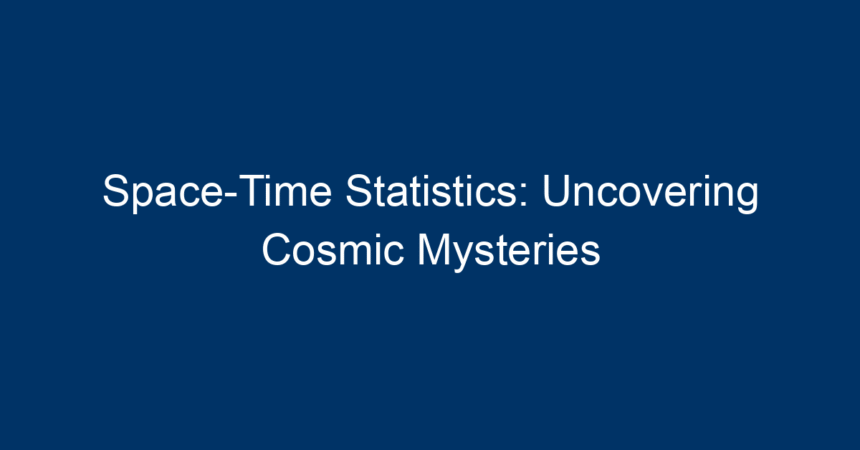The universe is a grand tapestry of intricate patterns and phenomena waiting to be understood. Among the most fascinating paradigms scientists use to decode cosmic mysteries is space-time statistics. This discipline blends the realms of physics, mathematics, and astronomy to analyze and interpret data about the universe’s structure and behavior. In this article, we will delve into the role of space-time statistics in modern astrophysics, explore its applications, and consider its potential for unveiling deeper cosmic secrets.
What Are Space-Time Statistics?
Space-time statistics refers to the study of data related to spatial and temporal phenomena. It combines elements from spatial statistics, which deal with the analysis of geographical and astronomical data, and time series analysis, which focuses on temporal data. Together, they provide a framework for understanding how certain phenomena occur over time and within specific locations in the universe.
The Importance of Space-Time Statistics
In the context of astrophysics, space-time statistics is crucial for several reasons:
-
Understanding Cosmic Structures: With comprehensive data collection methods such as telescopes and satellites, scientists can gather extensive datasets that describe the distribution of galaxies, stars, and other celestial bodies. Space-time statistics helps in analyzing these datasets to uncover patterns.
-
Detecting Anomalies: Space-time statistics allows researchers to identify anomalies in data that could signify unknown phenomena or cosmological events, such as dark matter interactions or gravitational waves.
- Predicting Cosmic Events: By employing historical data, space-time statistics aids in forecasting future cosmological events, providing insights into the evolution of the universe over time.
Applications of Space-Time Statistics
Analyzing Galactic Distributions
One of the most significant applications of space-time statistics is in the study of the large-scale distribution of galaxies. Researchers use statistical models to analyze the spatial distribution of galaxies across the universe. By utilizing cosmic microwave background radiation data and galaxy surveys, they can examine clustering patterns and understand how galaxies formed and evolved.
Gravitational Lensing Studies
Gravitational lensing occurs when the gravitational field of a massive object distorts the space around it, affecting the light from objects behind it. Space-time statistics allows scientists to analyze these distortions to infer properties of both the lensing object and the objects being lensed. By statistically quantifying the effects, researchers can gain insights into dark matter and the expansion of the universe.
Cosmic Microwave Background (CMB) Analysis
The Cosmic Microwave Background is a remnant of the Big Bang, providing invaluable information about the early universe. Through the lens of space-time statistics, scientists can analyze fluctuations in the CMB radiation to understand the universe’s infancy, tracing back to the formation of galaxies and the overall geometry of space-time itself.
Methodologies in Space-Time Statistics
Spatial Point Processes
Spatial point processes are used to understand the distribution of points (like stars or galaxies) in a given area. These processes apply probabilistic models to explain how points cluster or disperse across the universe. This methodology is foundational in analyzing large astronomical datasets to derive meaningful insights.
Time Series Analysis
Time series analysis is employed to interpret the temporal trends of cosmic phenomena. For example, analyzing the brightness of variable stars over time allows researchers to understand stellar evolution and looking for periodic patterns indicates larger cosmic interactions.
Statistical Modeling
Statistical modeling encompasses a range of analytical techniques that codify relationships between different cosmic variables. These models can help scientists predict future behaviors of astronomical events based on historical data, enhancing our understanding of cosmic cycles.
Challenges in Space-Time Statistics
Despite its incredible potential, space-time statistics faces several challenges:
-
Data Quality: The vastness of space introduces complications in data collection. Variability and noise in astronomical data can obscure genuine cosmic signals, requiring sophisticated filtering techniques.
-
High Dimensionality: The datasets involved are often high-dimensional, incorporating numerous variables that interact in complex ways. This complexity poses significant challenges in model development and interpretation.
- Computational Demands: The sheer volume of data necessitates advanced computational methods for analysis, making it resource-intensive and often time-consuming.
The Role of Simulation in Space-Time Statistics
Simulations play a pivotal role in space-time statistics by allowing researchers to model cosmic phenomena under controlled conditions. By creating virtual universes, scientists can test hypotheses about galaxy formation, cosmic expansion, and more.
These simulations generate synthetic data that help refine statistical models, facilitating a deeper understanding of how space-time dynamics function. This cyclical relationship between simulation and analysis is crucial for advancing our grasp of the cosmos.
Future Directions in Space-Time Statistics
As technology advances, the field of space-time statistics is poised for growth. Potential future directions include:
Enhanced Data Collection
Improved observational technologies, such as next-generation telescopes and satellites, are expected to produce richer datasets. This influx of high-quality data will provide more opportunities for analysis and uncover hidden cosmic phenomena.
Integration of Machine Learning
The application of machine learning algorithms to space-time statistics holds immense promise. These tools can help identify complex patterns in large datasets, improving accuracy and efficiency in data analysis.
Collaborative Research Efforts
Interdisciplinary collaboration between statisticians, physicists, and astronomers will foster innovative approaches to space-time data analysis, allowing for a holistic understanding of cosmic mysteries.
Conclusion: Unveiling Cosmic Mysteries with Space-Time Statistics
In summary, space-time statistics serves as a powerful tool in the quest to uncover the mysteries of the universe. By combining spatial and temporal data analysis, researchers can illuminate the hidden structures and behaviors that govern the cosmos.
From analyzing the distribution of galaxies to understanding gravitational lensing and the Cosmic Microwave Background, the applications of space-time statistics are vast and varied. However, the field continues to face challenges, particularly regarding data quality and computational demands. Thankfully, advancements in technology and methodologies—particularly through machine learning—promise to enhance our analytical capabilities.
As we move forward, embracing collaboration and innovation will be key to leveraging space-time statistics to its fullest potential. Armed with these insights and methods, we stand on the brink of new discoveries that promise to reshape our understanding of the universe.
Actionable Insights
- Stay Informed: Follow advancements in astronomy and statistics to keep abreast of new methodologies in space-time analysis.
- Engage with Data: Explore open-access astronomical datasets available online to practice your analytical skills.
- Collaborate: If you’re in a related field, consider engaging with experts in physics and statistics through workshops or seminars to spur interdisciplinary collaboration.
By diving deep into the cosmos through the lens of space-time statistics, we can unlock the secrets of our universe, one data point at a time.




